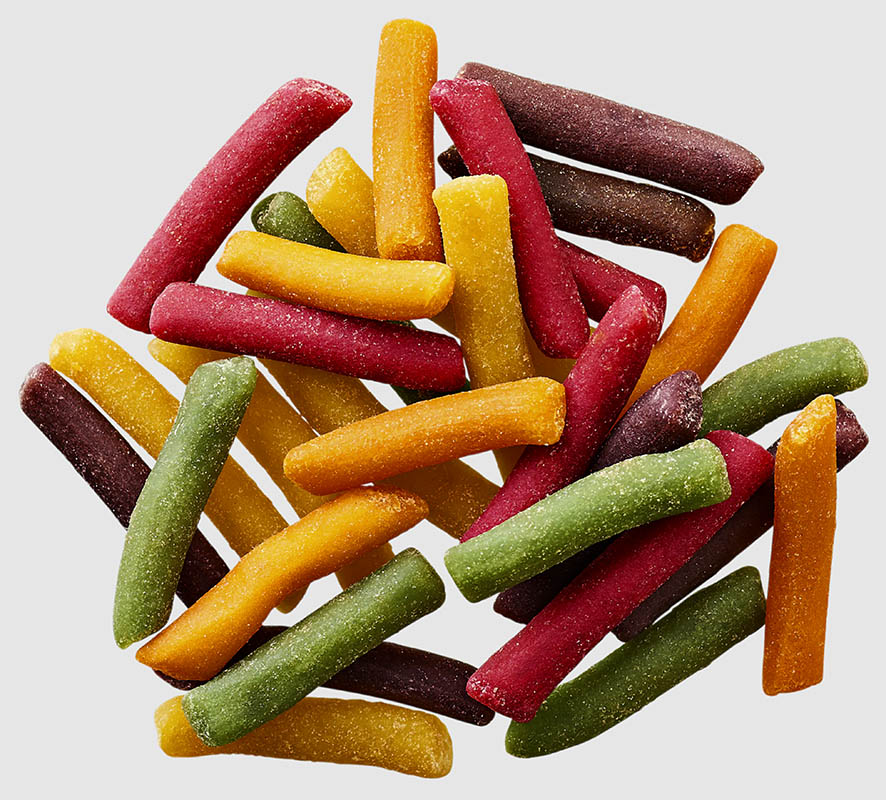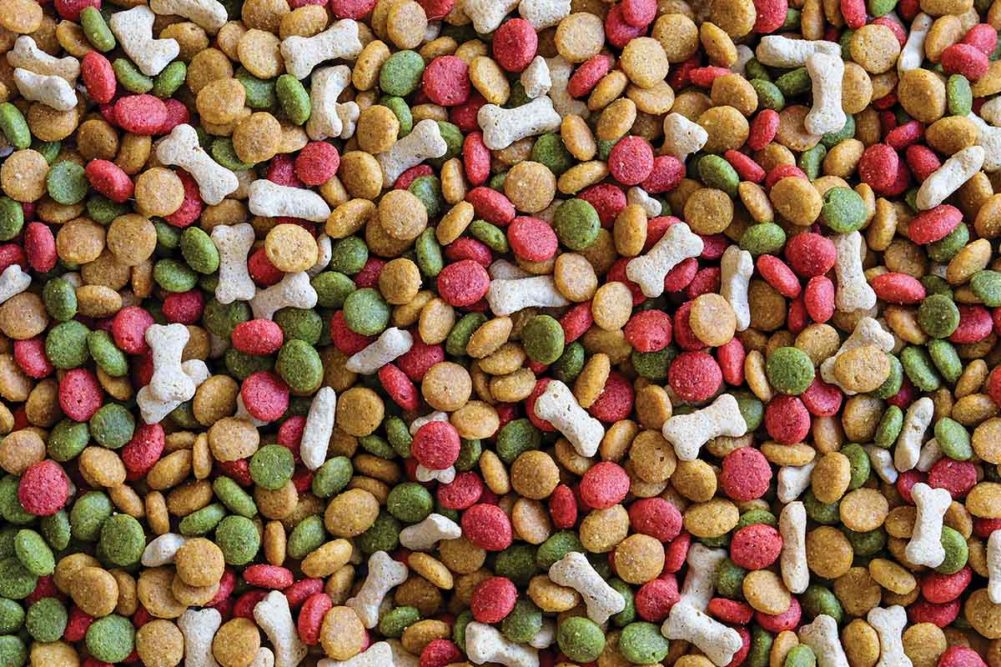This article was published in the September 2022 issue of Pet Food Processing. Read it and other articles from this issue in our September digital edition.
When shopping for foods and treats for their furry companions, pet parents rely on colors to form an opinion of how the product will taste to their cat or dog. That’s because humans eat with their eyes first. Having a visually appealing product boosts the perception of not only what a flavor is but also the overall food quality and experience. And while cats and dogs do not see the same spectrum of color as humans, appealing to pet parents is paramount.
“Appearance is one of the few things pet parents have to go off of when selecting foods and treats for their animals,” said Amanda McVicker, application technologist, IFF Nourish, South Brunswick, NJ. “The largest reason we see customers adding color is for batch-to-batch consistency. Even slight alterations of temperature and time in the manufacturing process can have an effect on color.”
Meghan Fox, marketing specialist, sensient food colors, Sensient Technologies, St. Louis, added, “Color helps compensate for inconsistent ingredient or base colors. Shoppers want to open a new bag of the same kibble they’ve been purchasing for their cat or dog for months or years and have it look the same as the last bag and the next one. Color can also be used to convey premium ingredients or nutritional positioning.”
 Even though dogs and cats wouldn’t complain, pet foods would look unappetizing without added color. (Source: Oterra)
Even though dogs and cats wouldn’t complain, pet foods would look unappetizing without added color. (Source: Oterra)
For example, if spinach or red meat are claimed as top-tier ingredients, pet owners expect to see appropriate green and red colors represented. Similarly, if chicken or another white meat is touted as an ingredient, a whitening solution may be needed to brighten up or cover darker notes from other ingredients in the formula.
“Colors also provide a fresh, appetizing look for shelf stable products, which typically would be unappetizing,” said Ashlee Martin, senior application scientist, Oterra, Denmark. “Colors create contrast and can brighten products to make them look healthier and meatier.”
Kent Cooper, co-owner, Evolve Consulting Group, Freemont, Neb., added, “Sometimes pet products are formulated with visual inclusions of fruits and vegetables that not only bring nutritional benefits, but also provide a pop of color to the product without using an actual colorant.”
Intensity matters
The more intense the color, the more the associated flavor humans expect. A bright orange chewy treat would likely have strong cheesy notes, while a dark brown kibble may be extra beefy.
“Lightness and darkness matter more than shade to both cats and dogs,” Martin said. “So, in terms of pet food, the right natural color can create contrast and brighten products to increase their appeal, and make them look healthier, or perhaps meatier to the pet.”
“Colors create contrast and can brighten products to make them look healthier and meatier,” said Ashlee Martin, Oterra.
Brett Volmert, pet food market lead, North America, IFF Nourish, St. Louis, said, “Humans have three types of cones that detect reds, blues and greens. Dogs only have two types of cones, which detect blues and yellows, and cats also only have two types of cones, which detect more blue-violet hues. But both cats and dogs have more rods than humans, which allows them to pick up more light and have far superior sight in low-light conditions.”
Cats and dogs see color similar to a red-green color-blind person. They simply cannot detect red or green and any variations.
“Those colors, and any colors made from a blend of red will appear in the brown spectrum, which is still different from grey hues,” said Ryan Guldenpfennig, veterinarian, Kemin, Des Moines, Iowa. “Dogs and cats are also able to distinguish brightness of colors, but about half that of humans. Moral of the story, if you want to attract a pet’s attention, the most effective colors to use would be yellow and blue.”
Another reason why formulators add color to pet food is research shows that if the parent doesn’t like how it looks, neither will the pet.
“While cats and dogs aren’t known for their color differentiation, a 2014 release from the Consumer Research Center at Kansas State University concluded that overall liking of dog kibble was greatly influenced by appearance,” Fox said. “The prediction of whether a dog liked the kibble was highly correlated with whether the owner liked the kibble. The research also concluded that dry dog food will be well-liked by owners if the kibble varies in color, has uniform shape and has low aroma.”
 Research shows that if the pet parent doesn’t like the way a pet food looks, neither will the pet. (Source: ©LIGHTFIELD STUDIOS – STOCK.ADOBE.COM)
Research shows that if the pet parent doesn’t like the way a pet food looks, neither will the pet. (Source: ©LIGHTFIELD STUDIOS – STOCK.ADOBE.COM)
As a follow-up to this published academic research, Sensient conducted online consumer research to evaluate the role of color in pet owner preference. In several iterations of this online testing, the most colorful kibble selection consistently won over lower color or monochrome alternatives.
“Purchase intent was substantially higher for the most colorful option over any alternatives,” Fox said. “Color matters, and it makes a quantifiable difference to pet owners. The colors used should be optimized to fit both the positioning within the market and the target audience.”
Know your options
Artificial color additives are specifically formulated to contribute only color. Most natural colors are used at such low levels that they, too, do not add flavor or aroma to the finished product.
“As the humanization of pets continues, pet parents want products to be as natural as possible,” said Lisa Schole, co-owner of Evolve Consulting Group. “Typically, artificial colors are not viewed positively by pet parents wanting natural clean label products. This has created interest in a line of natural colorants, many of which are derived from fruit juice concentrates, plants and even insects.”
Martin added, “Some vegetable juice colors, like orange carrot, could be added at a higher level if flavor contribution is what you are looking for.”
Oterra offers many color options suitable for pet foods and treats, including sweet potato, turmeric, annatto, paprika, orange carrot, carmine, black carrot, beet and radish. The colors come in powder, liquid- and oil-soluble formats. Selection is based on the type of product and how it is manufactured and distributed.
 Sweet potatoes, turmeric, paprika, carrots, beets and radishes can all be used to add color to pet foods and treats. (Source: STOCK.ADOBE.COM)
Sweet potatoes, turmeric, paprika, carrots, beets and radishes can all be used to add color to pet foods and treats. (Source: STOCK.ADOBE.COM)
“Sometimes you will get a slight sweetness from fruit juices, like apple or beet juice, but for the most part, the colors do not add flavor,” McVicker said.
IFF offers a rainbow of colors that can be used in pet food and treats. The color format is mostly the manufacturer’s preference.
“Often sites are set up to either work with liquids or powders,” McVicker said. “Once the color is mixed in and solubilized, it would act the same regardless of whether it started as a liquid or a powder.
“We can add orange colors like paprika or annatto to a cheese-flavored treat,” McVicker said. “Add yellows like turmeric and beta carotene to make a brown treat look more like peanut butter, or add green to a dental stick with a minty flavor.”
Sensient offers developers in the pet space everything from extrusion-stable reds to light-stable yellows. The company also has more unusual shades like purples or whites for yogurt coatings on treats.
“Some of our most popular solutions are a heat-stable beet solution and an extrusion-stable caramel-free natural brown with fruit juice labeling,” Fox said. “Heat stability is one of the most common challenges because of the frequency of baking and extruding these products. High-heat processing can be incredibly harsh on natural color ingredients, so Sensient has developed a deep portfolio of heat-stable solutions for each color in the rainbow appropriate for pet products.”
Many pet foods and treats are fortified. These ingredients often contribute to a dark base color, which can make it challenging to color.
“Recent trends in dog treats have emerged where bright colors are being used in similar ways to human sweet treats, such as frosting on baked biscuits,” said Alice Lee, technical marketing manager, GNT USA, Dallas, NC. “We offer brown, yellow, orange and purple hues made from recognizable fruits and vegetables such as carrots, peppers, turmeric and apple. Most of these colors are stable to high temperature and high pH conditions.
“In high moisture products, such as aseptic, canned, refrigerated and frozen pet food, liquid colors are often preferred for ease-of-use but powder colors could also be used as long as there is enough water for hydration,” Lee said. “In some extruded low-moisture systems where water must be managed, there may be a preference for powder formats.”
Overcoming formulation challenges
As with all foods, for humans or pets, there are technical challenges that must be addressed to maintain product quality, including cost and stability.
“Oxidation can be a challenge for pigments like paprika and beta carotene,” Martin said. “So when using these colors you would want to make sure to include an antioxidant in the formula.”
The pH of the product is a concern with some natural pigments based on anthocyanins. The pH may impact the final shade and stability. This is mostly an issue in wet, fresh foods, where pH may change over time.
“Light is a challenge for certain pigments,” Martin said. “It can fade some colors, such as turmeric and annatto, so your packaging selection needs to account for this issue.”
Artificial or natural, adding color means adding costs. This is especially true of natural colors, which are the most unstable formats.
“Cost in use historically was a limitation, however, now with our improved agronomy programs and increased technology, colors are more affordable than in the past,” Martin said.
If you are going to invest in adding natural colors, it is smart to invest in preserving the hues throughout shelf life.
“Natural curing ingredients, such as cultured celery powder and cherry powder, as well as natural antioxidants like green tea, rosemary and acerola extracts, can aid in color protection,” said Jenna Callahan, Florida Food Products (FFP).
“Natural curing ingredients, such as cultured celery powder and cherry powder, as well as natural antioxidants like green tea, rosemary and acerola extracts, can aid in color protection,” said Jenna Callahan, marketing coordinator, Florida Food Products (FFP), Eustis, Fla. “Natural antioxidants can inhibit rancidity, which in turn inhibits color changes that may occur during oxidation.”
Guldenpfennig added, “Color preservation in pet foods and treats is generally done for the pet owner. If the preservative does not have any harmful effect on the animal, or better yet it has a potential positive effect, then we have no concerns in adding color preservatives. In addition, if the preservative is being used to protect phytonutrients that add color to food items, such as lutein, anthocyanins and zeaxanthin, then that is vastly more valuable for the health of the pet.”
Colors are here to stay for pet foods and treats. The consensus is that formulators will move away from synthetic versions to natural colors, as pet parents demand cleaner labels for their furry friends.
“The industry will continue to find new sources for natural colors and will work to find better solutions for greens and blues as they are more difficult to match with natural colors,” Martin said.
Fox added, “Pet owners want products that look more delicious and are better for their pets than ever before. Bright, natural colors are a key component of this advancement. Expanding the rainbow even further to include more options for bold, bright, stable shades in the pet space will further enable new product development and innovation.”
Read more about product development, ingredients and formulation.




